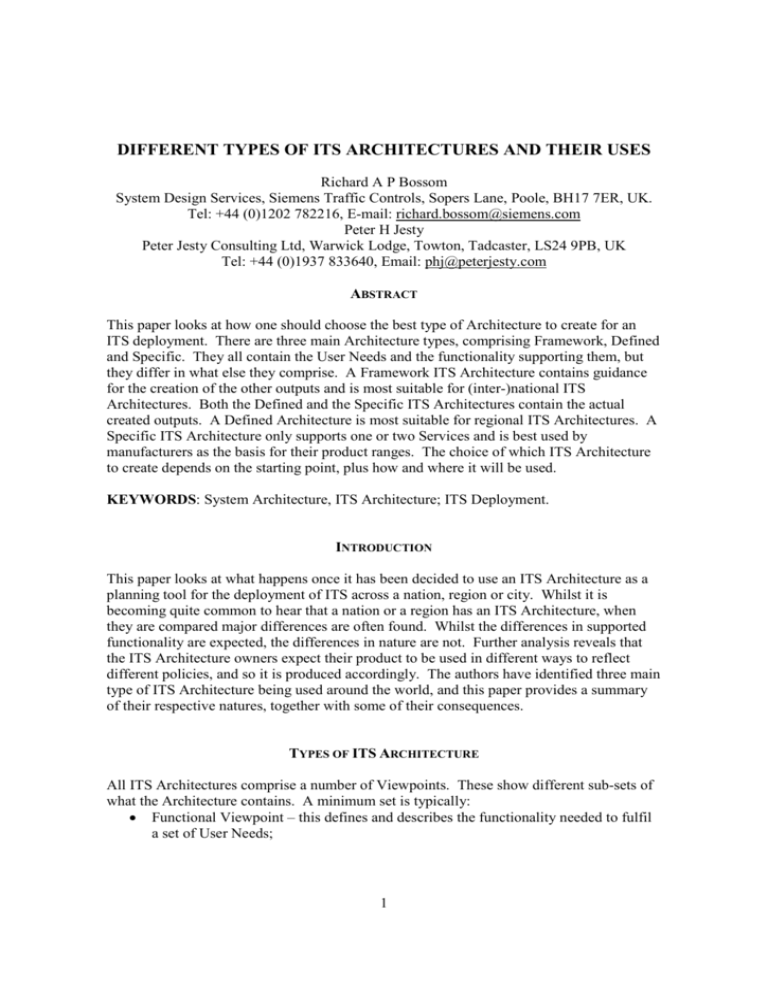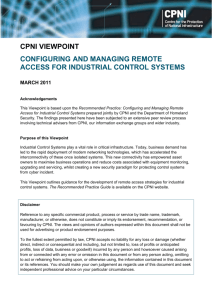- frame architecture
advertisement

DIFFERENT TYPES OF ITS ARCHITECTURES AND THEIR USES Richard A P Bossom System Design Services, Siemens Traffic Controls, Sopers Lane, Poole, BH17 7ER, UK. Tel: +44 (0)1202 782216, E-mail: richard.bossom@siemens.com Peter H Jesty Peter Jesty Consulting Ltd, Warwick Lodge, Towton, Tadcaster, LS24 9PB, UK Tel: +44 (0)1937 833640, Email: phj@peterjesty.com ABSTRACT This paper looks at how one should choose the best type of Architecture to create for an ITS deployment. There are three main Architecture types, comprising Framework, Defined and Specific. They all contain the User Needs and the functionality supporting them, but they differ in what else they comprise. A Framework ITS Architecture contains guidance for the creation of the other outputs and is most suitable for (inter-)national ITS Architectures. Both the Defined and the Specific ITS Architectures contain the actual created outputs. A Defined Architecture is most suitable for regional ITS Architectures. A Specific ITS Architecture only supports one or two Services and is best used by manufacturers as the basis for their product ranges. The choice of which ITS Architecture to create depends on the starting point, plus how and where it will be used. KEYWORDS: System Architecture, ITS Architecture; ITS Deployment. INTRODUCTION This paper looks at what happens once it has been decided to use an ITS Architecture as a planning tool for the deployment of ITS across a nation, region or city. Whilst it is becoming quite common to hear that a nation or a region has an ITS Architecture, when they are compared major differences are often found. Whilst the differences in supported functionality are expected, the differences in nature are not. Further analysis reveals that the ITS Architecture owners expect their product to be used in different ways to reflect different policies, and so it is produced accordingly. The authors have identified three main type of ITS Architecture being used around the world, and this paper provides a summary of their respective natures, together with some of their consequences. TYPES OF ITS ARCHITECTURE All ITS Architectures comprise a number of Viewpoints. These show different sub-sets of what the Architecture contains. A minimum set is typically: • Functional Viewpoint – this defines and describes the functionality needed to fulfil a set of User Needs; 1 • • Physical Viewpoint – this describes how (a sub-set of) the Functional Viewpoint will be deployed in a given situation; Communications Viewpoint – this provides an analysis of the Physical Data Flows to identify the characteristics of the physical links that will carry the data. The differences in the types of ITS Architectures relate to how these Viewpoints are defined and how they are to be used. There are three main types of ITS Architecture that can be developed for use as a planning tool in a particular ITS deployment. They are a Framework ITS Architecture, a Defined ITS Architecture and a Specific ITS Architecture. The relationship between them is illustrated in Figure 1. Figure 1 Relationship between the three different types of ITS Architecture Although Figure 1 implies that the basic contents of each type of ITS Architecture are the same, and the same basic creation process is used, there are some fundamental differences of approach. As can be seen, the relationship between the three types of ITS Architecture is one way. All three types may be created from the same set of Stakeholder Aspirations and it is possible to create more than one Defined and/or Specific Architectures from the same Framework Architecture. The three types of Architecture actually form a loose hierarchy, with the Framework Architecture being at the highest level. However this does not mean that it must always be created before either of the other two types of Architecture can be produced. The hierarchy is useful because it enables nations, regions and cities to decide how they want the Architecture that they create to be used. If for example a Nation wants to set a “standard” for the way that ITS Architectures are developed within its jurisdiction, it can create either a Framework Architecture or a Defined Architecture as the National ITS Architecture. The difference lies in the degree of flexibility that is given to those creating their own architectures from it and the amount of work needed to create them. 2 SPECIFIC ARCHITECTURES As its name implies a Specific Architecture is produced for a specific purpose, for example: • • A specific service over a region, e.g. road-based public transport; A plan for a city or a region. This is the “lowest level” of ITS Architecture, and will be defined by its Physical Viewpoint. Whilst the creators of the Specific Architecture will have used a Functional Viewpoint in the Architecture creation process, it is not always necessary to publish its contents. A Specific Architecture will be used to produce the component and infrastructure specifications to be used in implementing the proposed ITS deployment. The creation of additional architecture products, such as organisational analysis and risk analysis, are optional. An example of a Specific Architecture is the one that the authors are creating for an English County. The starting point for its creation is a set of Stakeholder Aspirations. These describe the services that the Stakeholders want to be implemented in the County. In this example, the Architecture creation process then maps these to the User Needs for a Framework Architecture, in this case those for the European ITS Framework Architecture – called the European ITS User Needs. The mapped User Needs are then used to identify the functionality that is needed from the Framework Architecture, thus creating the Functional Viewpoint for this Specific Architecture. If there is no mapping from the Aspirations to the European ITS User Needs, then new User Needs are created for the Specific Architecture. This in turn leads to the creation of new functionality, which is incorporated into the Functional Viewpoint for this Specific Architecture. From this Functional Viewpoint, the Physical Viewpoint for the County is then produced. The end results of the Architecture creation process are the required component and infrastructure specifications produced from the descriptions of the Sub-systems and Modules in the Physical Viewpoint. These specifications are then used in the next stages of the ITS deployment for the County. Further work such as the creation of a Communications Viewpoint, analysis of organisational issues and risks can be carried out as required by the County authorities. DEFINED ARCHITECTURES One form of a Defined Architecture “defines” how ITS will be deployed in a region, and is made up of “building blocks” that can be selected by its users to produce their own Specific Architectures. Since the owner of the Defined Architecture wishes to mandate how features of each application are to be created, it will be defined by a Physical Viewpoint, but in a 3 manner such that it is possible to “pick-and-mix” elements from that viewpoint for the various Specific Architectures that can be created from it. Although not necessary, it is likely that many of the other supporting documents will also be produced to aid its use, but the original Functional Viewpoint may not be published. Probably the most well known version of this form of a Defined Architecture is the US National ITS Architecture. This was created in 1996, but has been updated several times since then, with a new version to be produced shortly. Although it includes the three Viewpoints referred to earlier, users are presented with what are called Market and Equipment Packages from the Physical Viewpoint (the US calls it the Physical Architecture) to use in configuring their own Specific Architectures. Equipment Packages groups related parts of the functionality together into something that can be implemented. The grouping also takes into account the ITS User Services and the need to accommodate various levels of functionality. ITS User Services are statements of the Stakeholder goals that deployment of the Equipment Packages is intended to achieve. Market Packages are groups of Equipment Packages that provide an accessible, service-oriented perspective to the Architecture. Thus they identify those parts of the Physical Viewpoint that are required to implement particular ITS User Services, e.g. Public Transportation Management. To use the US National ITS Architecture the first thing that a user does is to select the ITS User Services that match the services that they want to deliver. This then enables the appropriate Market and Equipment Packages to be selected from the Physical Viewpoint. From these the specifications for the systems, equipment, communications infrastructure and user interfaces can be created. For the US Architecture the process of selecting the right Packages can be made easier by using the Turbo Architecture Tool (contact the McTrans Software Centre at the University of Florida at: mctrans@ce.ufl.edu to purchase a copy), which has been specifically designed for this purpose. Further information about the US Architecture can be found from its Web Site at: http://itsarch.iteris.com/itsarch/. It is also possible to produce a Defined Architecture that is in effect an expanded form of Specific Architecture. It will have large inflexible groupings of functionality, e.g. Urban Traffic Control. However it will still be possible to choose which of these large groupings to use for ITS deployments in different geographic areas. FRAMEWORK ARCHITECTURES A Framework Architecture is the most general and flexible approach to creating an ITS Architecture. It is used to capture what needs to be done to satisfy a given set of Stakeholder Aspirations, rather than to mandate how they should be applied. A Framework Architecture comprises a set of User Needs and the Functional Viewpoint only, though it will probably have some of the supporting documents to show how it can be used, and to give examples of its use. Being flexible, a Framework Architecture can be used in various ways by various users. 4 European ITS Framework Architecture Stakeholder Aspirations List of European ITS User Needs Selected Sub-set Extra User Needs European ITS Framework Architecture Functional Viewpoint Sub-set Defined or Specific Architecture produced from the Framework Archtiecture Extra Functions Physical Viewpoint Communications Viewpoint, Risk Analysis and other results as required Figure 2 Using the European ITS Framework Architecture The most well known example of a Framework Architecture is probably the European ITS Framework Architecture. It has been designed so that it can be used as the starting points for a National, or Regional ITS Framework Architectures, or Defined and Specific Architectures as described previously. This approach will also give the users of the National and Regional ITS Framework Architectures great flexibility in how they can create their own Specific ITS Architectures. Alternatively, a (large) region of that nation may wish to develop a Defined ITS Architecture that would then be used by its members in 5 a more constrained manner. This relationship between the Framework Architecture and what can be created from it, has already been illustrated in Figure 1. In a Framework Architecture the Stakeholder Aspirations plus their supporting User Needs and Functional Viewpoint should cover a suitably wide range of services. For the European ITS Framework Architecture this means the range of service that is likely to be implemented at the European level. The flexibility in the Architecture can then be exploited by its individual users to add their User Needs and Functionality to cover services described in their Aspirations that are specific to their Nation, Region, city, etc. in which the results of the Architecture are to be used, as shown in Figure 2. The details of the ways in which a Framework Architecture can be used as the starting point for other Architectures is illustrated by Figure 2. It uses the example of the European ITS Framework Architecture as the starting point, but the methodology in the diagram could be applied to the Framework Architecture from any other part of the world. Using the European ITS Framework Architecture is supported by the FRAME Selection Tool, which enables users to select the sub-set of User Needs and supporting Functions that they need. They can then go on and use the selected Functions from which to build the required Physical Viewpoint. The Selection Tool is available from the FRAME Web Site, which can be found at: http://www.frame-online.net/. The Web Site also provides access to the FRAME Browsing Tool which can be used to study the contents of the European ITS Framework Architecture. ITS ARCHITECTURE CHARACTERISTICS The characteristics of each of the three types of ITS Architecture are slightly different. All have the same starting point but contain different outputs. This is illustrated in Figure 3. Framework ITS Architectures contain User Needs and the Functional Viewpoint, which defines the functionality needed to fulfil them. Each of the other possible outputs (e.g. Physical, Communications and Organisational Viewpoints, Deployment Plan, Risk Analysis and Cost/Benefit Study) is replaced by its own “creation guidance document”. Each of these documents should include examples of the creation of the particular output to which they apply. They should help users to create their own versions of these outputs when they need them for their own ITS deployments. Defined ITS Architectures again contain User Needs and the Functional Viewpoint, plus more importantly the Physical Viewpoint. This is the primary part of the Architecture that will be used for any future work. The other outputs will probably also be produced. These comprise the definition of the communications infrastructure to link the building blocks (Communications Viewpoint), plus what is needed of other outputs (e.g. Deployment Plan, Organisational Issues, Cost/Benefits and Risk Analysis) to suit the environment for that ITS deployment. If any flexibility is built into the Physical Viewpoint then it should be accompanied by “guidance documents” to explain its use. The other outputs may be 6 present, or may be replaced by “creation guidance documents”, particularly where their contents depend on how the flexibility in the Physical Viewpoint is exploited. Although needed to create the Physical Viewpoint, the Functional Viewpoint may not be published. Figure 3 Characteristics of the three ITS Architecture types Specific ITS Architectures have very similar contents to Defined ITS Architectures. The main difference is that a Specific ITS Architecture only supports a small number of ITS Services, such as traveller information, or electronic fee collection. There can therefore be 7 several Specific ITS Architectures for a particular nation or region. Each will be either a sub-set of its Defined ITS Architecture, or will have been created directly from a single (common) Framework ITS Architecture. In either case, all of the required outputs will be present and there will be no “creation guidance documents” for those that are not. CHOOSING THE RIGHT ITS ARCHITECTURE TYPE Selecting the most appropriate type of architecture to create for a particular ITS deployment depends on its eventual use and on the starting point for its creation. A Framework ITS Architecture is usually applicable for an (inter-)national architecture deployment, where it is expected that other more local architectures will be developed from it. The guidance documents that are in its outputs can be used to influence the development of these “local” architectures. A Defined ITS Architecture is usually applicable for regional ITS deployments, such as those for states, counties, or cities. It enables close control to be exercised over the outputs, particularly on the contents of the Physical and Communications Viewpoints. Several Defined Architectures can be created from one Framework Architecture, enabling each state, county or city to have its own architecture. However compatibility will be assured as all the architectures will have been developed from the same Framework Architecture. A Specific ITS Architecture is very similar to a Defined ITS Architecture but it only supports a small number of Services. It can be used in place of a Defined ITS Architecture, when a restricted set of Stakeholder Needs are to be considered. Additionally manufactures can use it as the basis for their product ranges. Again several Specific Architectures can be created from one Framework or Defined ITS Architecture, thus ensuring compatibility. Using the above information, it should be possible for those responsible for creating ITS Architectures to choose the right Architecture to create. One factor not mentioned previously that needs to be taken into consideration, is the amount of work involved in creating the required ITS Architecture(s). For example creating a Defined Architecture from no other Architecture takes a lot more effort than creating it from a Framework Architecture. Similarly creating a Specific Architecture from a Framework Architecture takes a lot more effort that creating it from a Defined Architecture. Therefore it is very important to look at the eventual use that is to be made of the ITS Architectures that are to be created and look to see if there are any other Architectures that can be used as starting points before any decision is taken. CONCLUSIONS Once it has been decided to create an ITS Architecture for an ITS deployment, the next issue to be resolved is which type. There are three ITS Architecture types to choose from, Framework, Defined and Specific. A Framework ITS Architecture is most suitable for 8 (inter-) national architecture deployments, whilst Defined ITS Architectures are more suitable for deployments for states, counties or cities. Specific ITS Architectures cover only a few Services, and may be used by manufacturers for product development. 9








